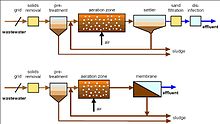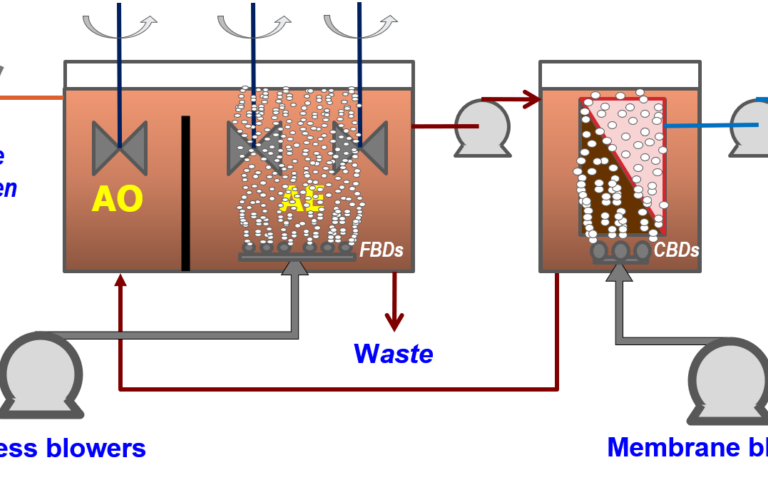Understanding the Basics of Membrane Bioreactor Systems for Wastewater Management
Understanding the Basics of Membrane Bioreactor Systems for Wastewater Management
Blog Article
Just How Membrane Bioreactors Are Revolutionizing Water Filtration Equipments
The emergence of membrane bioreactors (MBRs) stands for a significant improvement in the field of water purification, combining biological treatment procedures with cutting-edge membrane filtration innovations. As worldwide water shortage escalates, the role of MBRs in facilitating safe and clean water reuse and lasting water administration ends up being increasingly essential.
Summary of Membrane Layer Bioreactors
Membrane bioreactors (MBRs) stand for a considerable advancement in water filtration modern technology, as they integrate organic therapy processes with membrane purification. This assimilation enhances the performance of wastewater therapy by utilizing microorganisms to break down natural pollutants while simultaneously using semi-permeable membranes to separate treated water from suspended solids and pathogens.
The MBR system typically contains an organic activator where the microbial populace metabolizes impurities, complied with by a membrane layer filtering device that maintains biomass and enables just tidy water to go through. This twin performance leads to higher effluent high quality contrasted to traditional therapy approaches. MBRs can be run in both set and continual circulation settings, providing versatility in style and application.
Furthermore, MBRs are characterized by their small footprint, making them ideal for urban setups with area restrictions. Membrane Bioreactor. They also allow the healing of water for reuse, thus adding to water sustainability initiatives. While MBR modern technology has gotten popularity in local and industrial applications, its functional complexities and power demands require mindful factor to consider during execution. Generally, MBRs go to the forefront of improving water treatment effectiveness and top quality, showcasing the capacity for ingenious remedies in ecological administration.
Benefits of MBR Technology
The integration of biological treatment with membrane filtering provides various advantages for water purification processes. One of the primary advantages of Membrane Bioreactor (MBR) technology is its capacity to properly remove both not natural and natural impurities, bring about premium effluent. The membranes function as a physical barrier, protecting against put on hold solids and pathogens from passing through, which improves the general security and reliability of cured water.
Furthermore, MBR systems call for a smaller impact contrasted to standard therapy approaches, enabling for much more reliable room use. This small layout is particularly advantageous in metropolitan settings where land is limited. MBRs additionally demonstrate operational flexibility, suiting differing influent high qualities and circulation rates without considerable efficiency destruction.
In addition, the procedure offers enhanced nutrient removal abilities, especially for nitrogen and phosphorus, which are important for preventing eutrophication in getting waters. The decreased sludge production related to MBR modern technology also translates to reduce disposal prices, making it a cost-efficient service in the long run - Membrane Bioreactor. Generally, the advantages of MBR innovation setting it as a leading selection for sustainable and cutting-edge water filtration systems, attending to both environmental and financial problems
Applications in Water Purification
Applications of Membrane Layer Bioreactor (MBR) modern technology in water filtration are impactful and diverse, resolving different treatment requires throughout multiple fields. MBRs efficiently integrate biological treatment processes with membrane filtering, making them ideal for municipal wastewater treatment, industrial effluent monitoring, and also drinkable water reuse initiatives.
In municipal settings, MBRs are increasingly utilized to improve the quality of treated wastewater, enabling conformity with rigorous discharge laws and helping with the recycling of water for irrigation and non-potable uses. Their portable design likewise makes them suitable for metropolitan settings where room is restricted.
Industrially, MBR modern technology is used to treat procedure water and wastewater, particularly in markets such as food and drink, drugs, and textiles. By properly eliminating contaminants and suspended solids, MBRs assist industries lessen ecological effects while recovering important resources from wastewater streams.
In Addition, MBRs are acquiring traction in decentralized water therapy applications, where small-scale systems can be deployed in remote areas or creating areas. This adaptability enables communities to attain sustainable water monitoring services, improving accessibility to clean water while decreasing click for info dependence on standard treatment techniques.
Study and Success Stories

In another instance, a textile manufacturing facility in Bangladesh embraced MBR innovation to resolve its wastewater obstacles. The system lowered chemical oxygen need (COD) levels from 1,200 mg/L to much less than 100 mg/L, therefore fulfilling regulative standards and significantly reducing environmental impact.
The College of Cape Community's MBR installment has confirmed efficient in treating greywater for non-potable reuse on university. This project not only preserves potable water yet additionally acts as an educational version for lasting practices.
Additionally, a seafood processing plant in Norway made use of MBR modern technology to deal with effluents having high levels of organic matter, accomplishing over 90% toxin removal. These situation research studies highlight MBR innovation's flexibility and its vital duty in improving water quality across varied applications.
Future of Water Therapy Solutions
As international water deficiency and contamination obstacles heighten, cutting-edge water therapy remedies are becoming increasingly necessary to ensure sustainable accessibility to tidy water. The future of water treatment depends on the assimilation of advanced modern technologies that boost the effectiveness and efficiency of filtration procedures. Membrane layer bioreactors (MBRs) go to the leading edge of this advancement, integrating organic treatment with membrane filtering to generate premium effluent appropriate for various applications.

Emerging patterns such as source healing from wastewater, including nutrients and energy, will certainly additionally transform therapy facilities right into environmentally friendly centers. In addition, innovations in nanotechnology and membrane layer materials guarantee boosted performance and longevity of filtration systems.

Final Thought
To conclude, membrane layer bioreactors stand for a considerable advancement in water filtration modern technologies, efficiently combining biological therapy with sophisticated membrane filtering. The various advantages, including enhanced effluent high quality and reduced spatial requirements, make MBRs especially suitable for metropolitan applications. Their duty in potable water reuse and lasting water management highlights their relevance in dealing with global water deficiency difficulties. Proceeded research and advancement will additionally Bonuses enhance the efficacy and fostering of MBR innovation, making certain a resilient future for water therapy solutions.
The development of membrane bioreactors (MBRs) represents a considerable innovation in the field of water purification, combining organic therapy procedures with sophisticated membrane layer purification technologies. As global water deficiency heightens, the duty of MBRs in facilitating drinkable water reuse and sustainable water monitoring becomes significantly important. They also allow the healing of water for reuse, hence contributing to water sustainability campaigns.As global water scarcity and air pollution challenges intensify, ingenious water therapy remedies are coming to be significantly important to guarantee sustainable access to clean water. Their role in safe and clean water reuse and sustainable water management highlights their value in attending to international water shortage difficulties.
Report this page